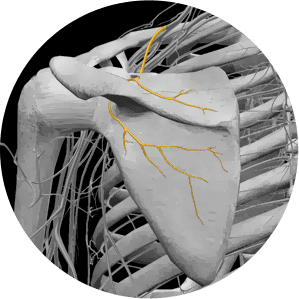Understanding
Neck and Shoulder Pinched Nerve Pain
Your neuromuscular system represents the critical connection between your brain and your muscles, governing and coordinating movement and sending messages to and from the brain about your body’s position in space, muscle contractions and sensory information. When nerves become impinged, or pinched, neural messaging is impeded, and you experience pain at the nerve root, along with motor deficiencies and reduced performance in the muscles associated with the nerve.
Nerves that exit from the intervertebral spaces in your neck govern your upper back, chest, shoulder and arm muscles, and those nerves can restrict movement and cause pain throughout your upper body. When nerves that innervate your rotator cuff muscles are impinged, you may feel pain and weakness in your shoulders and shoulder blades that inhibits overhead arm movement.

Nerve impingement is pressure on a nerve root imposed by another body structure. Inflammation of soft tissues surrounding the nerve, or pressure from a bone, cyst or connective tissue can cause impingement. Pressure can also originate within the vertebral space from a bulging or herniated disc that puts pressure on an adjacent nerve.
Nerve entrapment is related to but distinct from nerve impingement. It occurs when a nerve adheres to bone by fibrous tissue, when a bone is fractured, or when a cyst or large vein entraps the nerve, keeping it from gliding within the body as it moves.
When nerves are impinged or entrapped, blood flow to the nerve is restricted, interfering with its ability to transmit action potentials to the muscles. Over time, restricted blood flow can cause permanent damage to the nerve, limiting muscle activity and creating a cascade of movement and postural deficiencies that can become debilitating.
In older adults, normal wear and tear over time combined with postural deficiencies and joint conditions like arthritis can cause pinched nerves. In younger people, overuse from physical activity or injury are the most common causes of nerve impingement.

Symptoms of neck and shoulder pain may also stem from other sources, making accurate diagnosis a critical factor for treatment. A patient history and physical exam will precede and be confirmed by real time diagnostic ultrasound, which gives a close up view of the structures of the neck.
Please explore more advanced diagnostic option unavailable anywhere else:


Traditional treatment for pinched nerve pain targets the locus of pain with the aim of reducing inflammation and decreasing pressure on the nerve. Treatment may include:
The sports medicine professionals at NYDNRehab use state-of-the art technologies and innovative treatment methods to identify and correct compressed and entrapped nerves.
Some of our treatment methods include:
Many of our technologies and treatment approaches are unique to our midtown Manhattan Physical Therapy clinic, and cannot be found at other clinics. Our end goal is to go beyond treating pain, to getting to its source, eliminating it, and restoring optimal function to the patient.

Dr. Lev Kalika is a world-recognized expert in musculoskeletal medicine. with 20+ years of clinical experience in diagnostic musculoskeletal ultrasonography, rehabilitative sports medicine and conservative orthopedics. In addition to operating his clinical practice in Manhattan, he regularly publishes peer-reviewed research on ultrasound-guided therapies and procedures. He serves as a peer reviewer for Springer Nature.
Dr. Kalika is an esteemed member of multiple professional organizations, including: